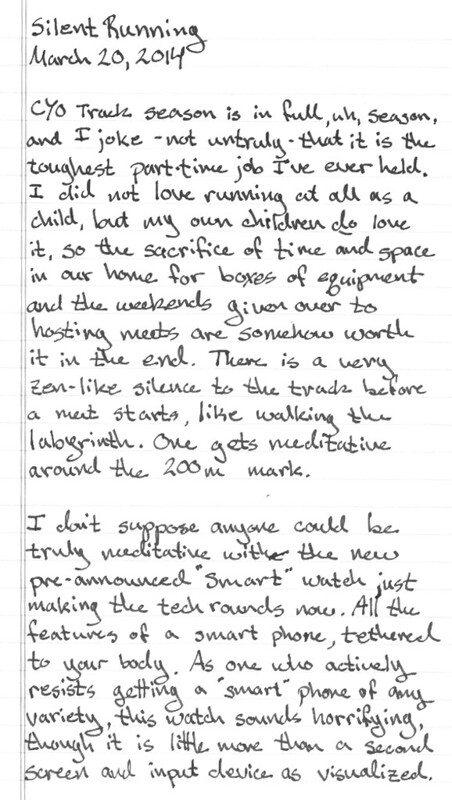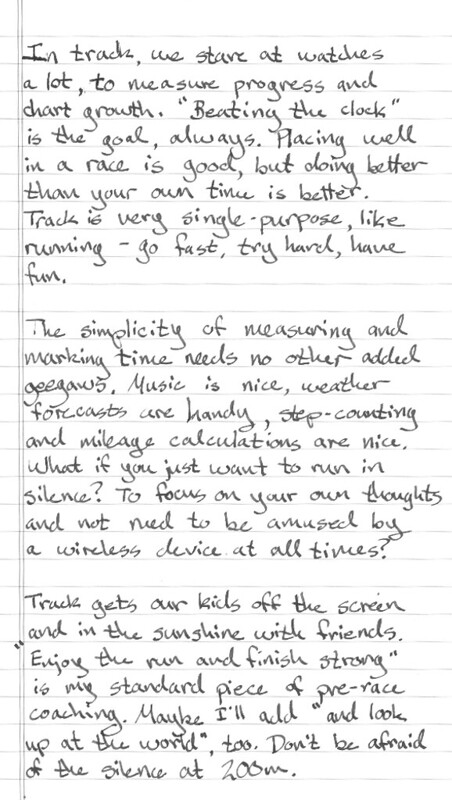For best effect, play while reading...
When I saw the
post last month on Rhodia Drive about the chance to test-drive a pair of their writing pads -- one with yellow, one with white paper -- I was perhaps a
tiny bit interested. I already have a
professed love for the bright orange brand, having been turned on to its magical ink-friendly properties by
the enablers at Fountain Pen Network. And I know the generosity of their marketing department with samples, so of course I threw the Clickthing hat in the ring, and then waited (im)patiently for a confirmation email, and ultimately a package from
Exaclair. The package arrived yesterday,
and I am not disappoint, as the kids say.[1]
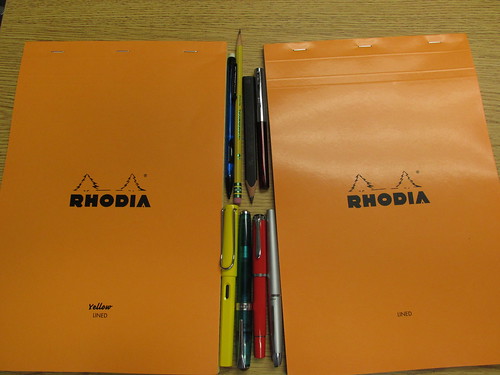 Two A4 tablets, 80 pages each... oooh, be still, my paper-lovin' heart
Two A4 tablets, 80 pages each... oooh, be still, my paper-lovin' heart
You can go back and read the original post, but the upshot of this trial is:
the yellow paper is "toothier" than the white. It's already been confirmed by Stephanie at Rhodia Drive, but this offer is to try it out with other writing instruments, and then report back to Exaclair/Rhodia HQ. As I love me a paper test, I of course set to gathering the competitors in what I'm modestly calling:
The Paperlympic Games of 2014
I agreed to test them out with pens, and test them I shall. And since I'm curious, I also want to try them out with whatever pencils I have here or could scrounge from the office supply room at work. You can see them in their parade formation as they entered the stadium, but we caught them in a more relaxed moment back in the athlete dormitories.
The Athletes
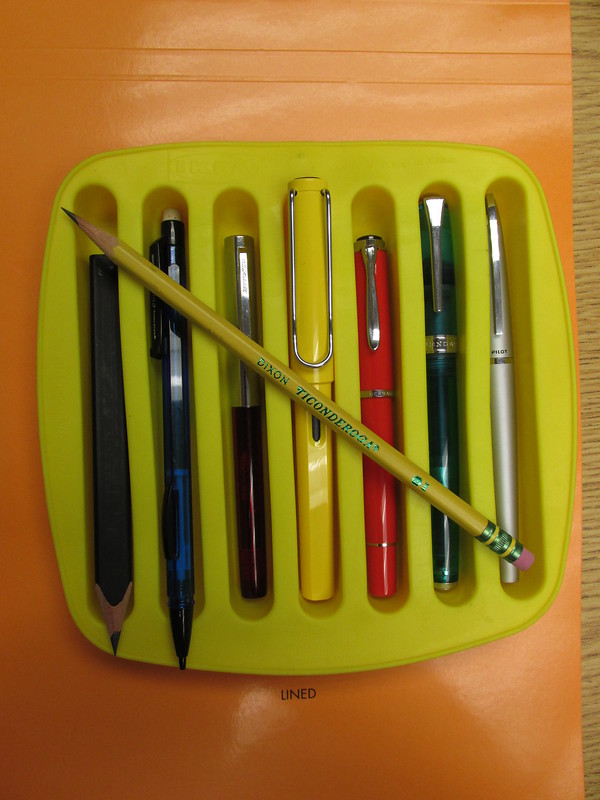 The competitors, in a moment of repose
The competitors, in a moment of repose
Like Sochi, there are some small issues of comfort that need to be sorted out, but generally everyone is happy. From left to right, the competitors are:
- Representing the Czech Republic: the Moleskine brand 2B hipster pencil
- Representing probably China: the Sanford Clickster 0.5mm mechanical pencil
- Laying crosswise, another China entrant: the Dixon Ticonderoga 2HB woodcase pencil
- From the United States of America, a late-80s vintage Sheaffer school pen, F nib with period Skrip jet black ink
- Representing Germany, the Lamy Safari, F nib with Lamy blue ink
- Also from Germany, a Pelikan m205, M nib with Waterman Serenity Blue ink from France
- From, um, Levengerland, a True Writer demonstrator, M nib with modern Sheaffer Skrip blue/black from Slovenia
- From Japan, a Pilot Knight with a M italic nib from a Plumix pen, inked with Pilot/Namiki blue/black
Let's have a round of applause for them, everyone!
The Field of Competition
For the qualifying round, athletes will go head-to-head on these carefully-manicured surfaces.
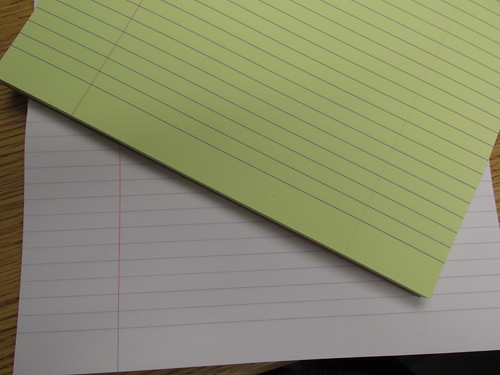 All markings follow IPC guidelines
All markings follow IPC guidelines
On the surface -- ha! -- this paper appears to be the same. Both are 80g/m
2 "High Grade Vellum Paper," both lined with margins. Both feature heavy foldover covers and a stiffish piece of cardboard affixed in the back to provide support for writing. Both are staple-bound with a fine perforation along the top edge to enable easy removal. Both feature Rhodia's purple lines with a red margin, though the lines appear darker on the yellow paper, and a bit brown, likely thanks to the color contrast.
Identical but for paper color, yes? Well, that's what we're here to find out.
For more, let's go over to the field where our on-the-scene reporters are standing by with some insightful color commentary.
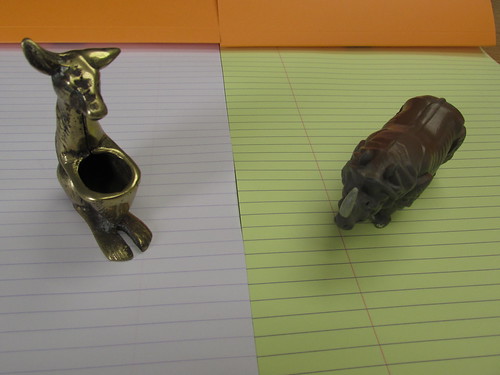 This does not bode well
Roo:
This does not bode well
Roo: Too right! It's as pale as a wallaby's bumhole! [2] Crikey! Uluru!
Rhino: O HAI I SEE YELLO
...
Annnnnnnnnd with that, we'll go back to the studio.
The Judging
This one's a little tough, since I'm coming in with a bias; I know that I'm expecting the yellow pad to be a little scratchier with a pencil, so I'm mainly looking for other differences in feel between the two surfaces with the different instruments. It'll be as scientific and impartial as a blog post can be -- that is to say, it'll be chock full of baseless opinions [3] in which accidental facts may unintentionally appear.
I'm going to use each of these for the next week or so, and write up my opinions-carefully-phrased-as-facts, share them with Exaclair, and you lucky readers. Both of you.
But it doesn't stop there! In the interest of true fairness, and to explore the whole notion of blind studies and the scientific method, there is a second,
longer portion to the Paperlympics. Just as the real Olympic games feature countless variants on "two people ice skating together" [4] so, too, does the full-blown Paperlympics finals have an excruciating number of nearly-identical events.
I've prepared a number of samples of paper, in which the Rhodia is secretly mixed, for my daughter and I to test out at home. In this way, we'll be putting it not only through the paces of the paper-obsessed office worker, but also the rigors of the typical tweenage homeschooler. And we'll be turning it into something of a science lesson, too, by checking properties, assigning scores, and in the end, looking at the samples under a microscope (because
science.) She doesn't know which sample is which, so I'm hoping to eliminate at least a shade of bias. I will attempt to refrain from comments like "this next one is TOTALLY AWESOME AND FREE so score it accordingly, won't you?"
But first, we need to get through the early rounds of this fine, traditional, just-made-it-up-last-week sport. If you're anything like me, you just want to skip ahead to the finals and see if there's any spectacular crashes. Be patient! I'm sure with me at the helm, disaster cannot be too far behind.
So,
sports paper fans, stay tuned! We'll be back with results after this commercial break.
[1] No kids actually say this.
[2] No Australians actually say this.
[3] Opinions, it is said, are like bumholes. Everyone has one, and you should keep yours private. Especially if you're a wallaby.
[4] All of which are shown on evening TV at the expense of any other events, not that I'm still bitter, NBC-I'm-looking-at-you. Thank goodness for DVRs and/or
perfectly legal streaming.
